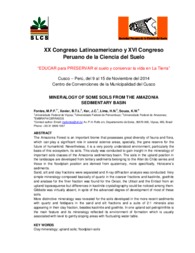Mineralogy of some soils from the Amazonia Sedimentary Basin.
Mineralogy of some soils from the Amazonia Sedimentary Basin.
Author(s): FONTES, M. P. F.; XAVIER, B. T. L.; KER, J. C.; LIMA, H. N.; SOUZA, K. W.
Summary: ABSTRACT: The Amazonia Forest is an important biome that possesses great diversity of fauna and flora, which can play a significant role in several science areas, specially, the gene reserve for the future of humankind. Nevertheless, it is a very poorly understood environment, particularly the basis of this ecosystem, its soils. This study was conducted to gain insight in the mineralogy of important soils classes of the Amazonia sedimentary basin. The soils in the upland position in the landscape are developed from tertiary sediments belonging to the Alter do Chão series and those in the floodplain position are derived from quaternary, more specifically, Holocene´s sediments. Sand, silt and clay fractions were separated and X-ray diffraction analysis was conducted. Very simple mineralogy composed basically of quartz in the coarser fractions and kaolinite, goethite and anatase for the finer fraction was found for the Oxisol, the Ultisol and the Entisol from an upland toposequence but differences in kaolinite crystallography could be noticed among them. Gibbsite was virtually absent, in spite of the advanced degree of development of most of these soils. More distinctive mineralogy was revealed for the soils developed in the more recent sediments with quartz and feldspars in the sand and silt fractions and a suite of 2:1 minerals also appearing in their clay fraction, besides kaolinite and goethite. In one upland soil petroplinthite is the main feature and its mineralogy reflected its environment of formation which is usually associated with level to gently sloping areas with fluctuating water table.
Publication year: 2014
Types of publication: Paper in annals and proceedings
Unit: Embrapa Cerrados
Observation
Some of Embrapa's publications are published as ePub files. To read them, use or download one of the following free software options to your computer or mobile device. Android: Google Play Books; IOS: iBooks; Windows and Linux: Calibre.
Access other publications
Access the Agricultural Research Database (BDPA) to consult Embrapa's full library collection and records.
Visit Embrapa Bookstore to purchase books and other publications sold by Embrapa.

